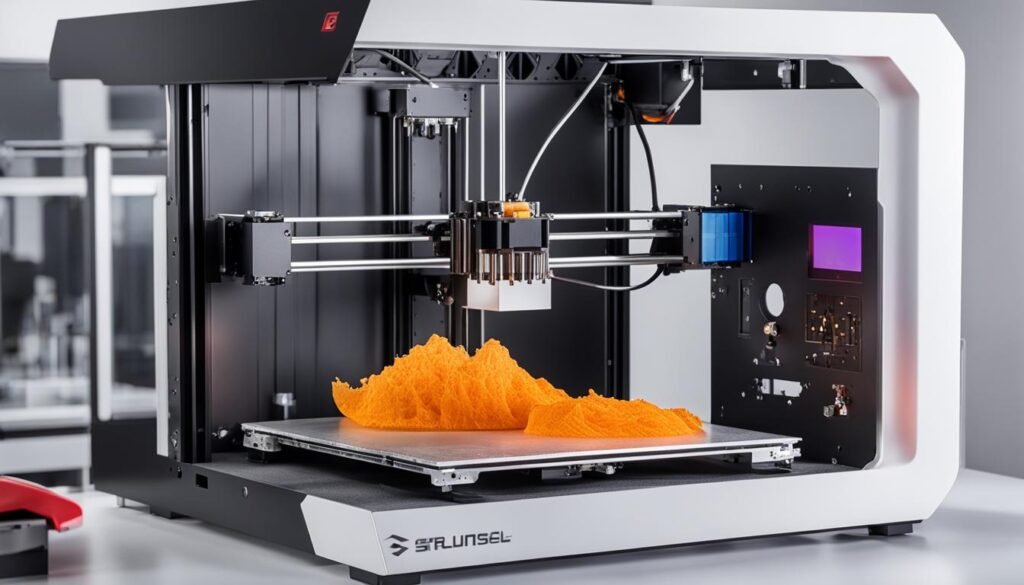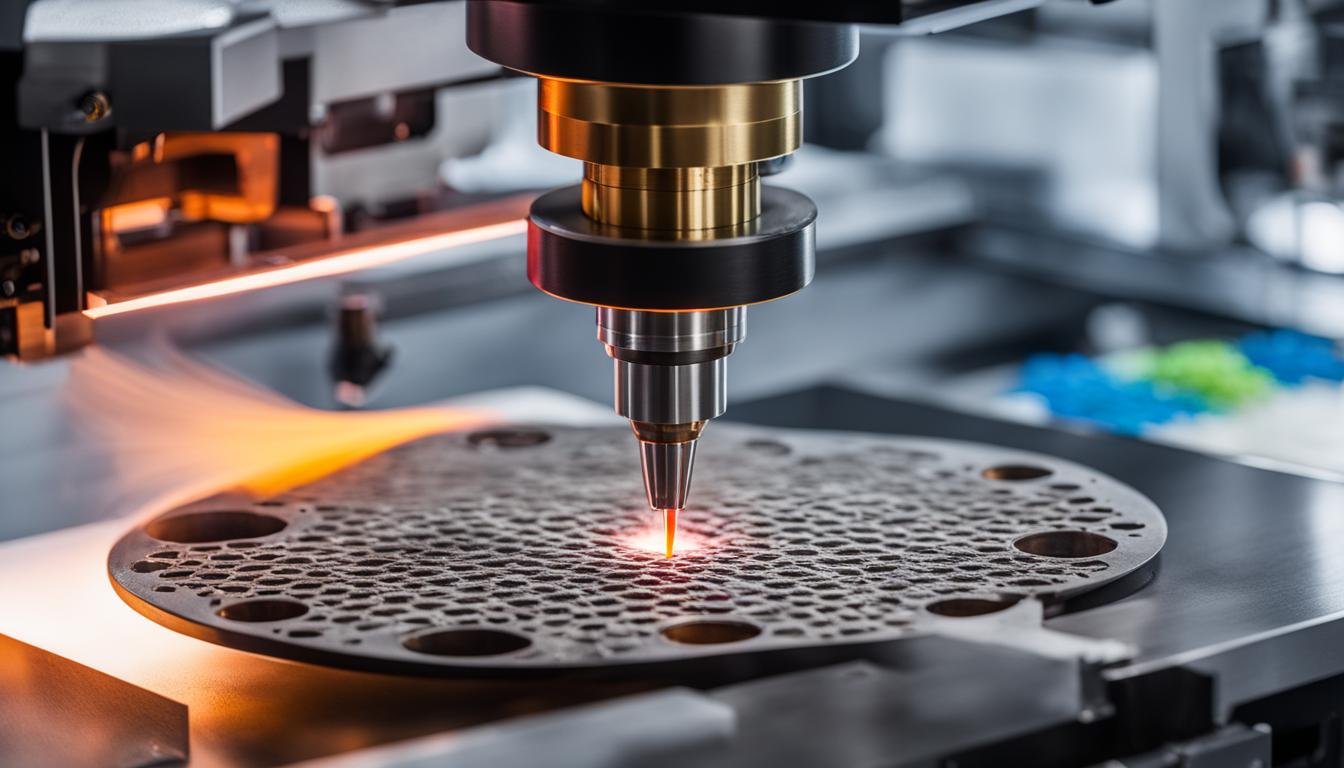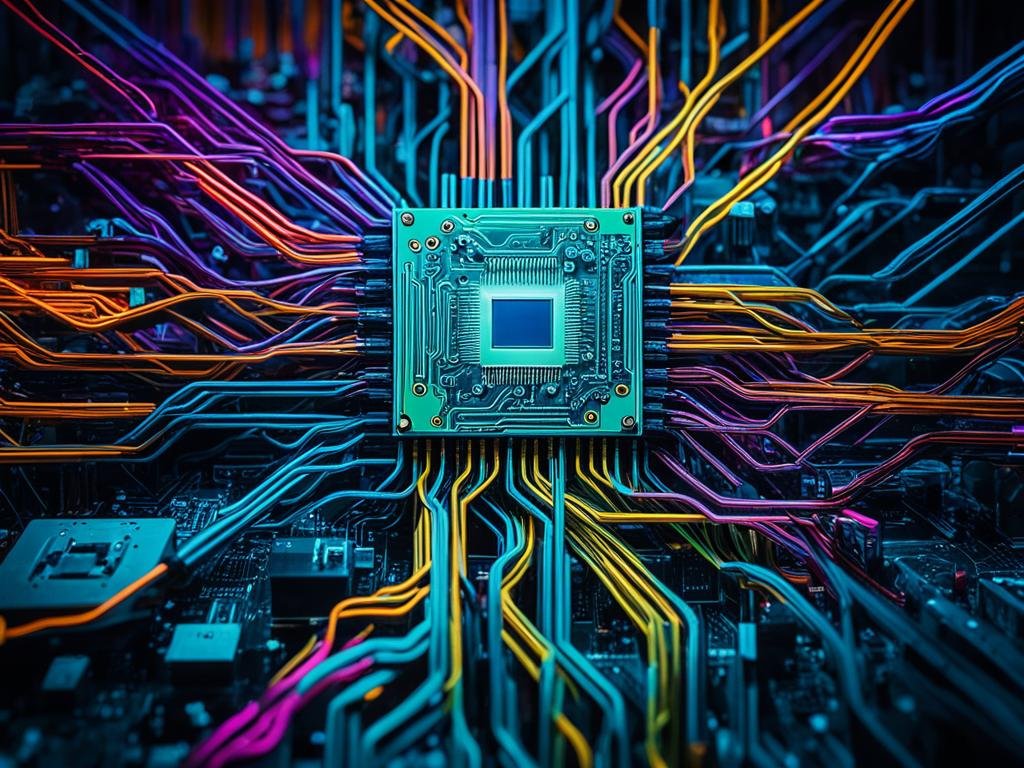Selective Laser Sintering (SLS) is a cutting-edge 3D printing technology that has revolutionized industrial manufacturing and rapid prototyping. By using a powder-based laser technology and thermoplastic powders, SLS offers a wide range of benefits for high-precision fabrication and customized production.
Unlike traditional manufacturing methods, SLS utilizes additive manufacturing to build objects layer by layer, allowing for more complex geometries and intricate designs. This makes SLS ideal for applications such as rapid prototyping, where speed and flexibility are crucial.
One of the key advantages of SLS is its versatility. It can work with a variety of materials, including nylon-based powders, which provide excellent strength and durability. The sintering process in SLS results in parts with high mechanical properties, making them suitable for a wide range of applications in industries such as aerospace, automotive, and healthcare.
The ability to produce customized parts and components is another major advantage of SLS. With SLS, manufacturers can easily create prototypes and end-use parts that are tailored to the specific needs of their customers. This level of customization can greatly improve product performance and customer satisfaction.
Moreover, SLS offers a high level of precision and accuracy, ensuring that each printed part meets the required specifications. This makes it a preferred choice for industries that demand intricate and complex designs.
Overall, Selective Laser Sintering (SLS) is a game-changer in the world of industrial manufacturing and rapid prototyping. Its ability to create high-quality, customized parts with exceptional precision and efficiency makes it an invaluable tool for businesses across various industries.
Key Takeaways:
- Selective Laser Sintering (SLS) is a versatile 3D printing technology ideal for industrial manufacturing and rapid prototyping.
- SLS offers high-precision fabrication, allowing for the creation of complex geometries and intricate designs.
- With SLS, manufacturers can produce customized parts tailored to their specific needs and customer requirements.
- SLS-printed parts have excellent mechanical properties and can be used in various industries, including aerospace and automotive.
- The precision and accuracy of SLS make it a preferred choice for industries that require intricate and complex designs.
Understanding the SLS Process
Selective Laser Sintering (SLS) is a fascinating 3D printing technology that utilizes a laser to gradually sinter layers of nylon-based powder, resulting in the creation of complex objects. The sintering process starts with the laser meticulously fusing each layer of the part geometry onto a heated bed of powder. Once a layer is complete, a roller evenly distributes the next layer of powder, and the process continues layer-by-layer until the final object is formed.
SLS printing is a precise and intricate layering technique, where each layer contributes to the overall structure, resulting in a strong and durable final product. This additive manufacturing process allows for the creation of intricate designs and shapes that would be challenging to achieve using traditional manufacturing methods.
The use of nylon-based powder in the SLS process offers distinct advantages. Nylon provides excellent mechanical properties, including high strength and durability. It is also a versatile material that can be utilized in various applications across industries.
Image:
The SLS technology, with its precision laser and layer-by-layer approach, allows for the production of highly complex objects with intricate details. The versatility of SLS printing lends itself to a wide range of applications, including rapid prototyping, customized production, and functional production parts.
Advantages of SLS Printing

There are several advantages to using Selective Laser Sintering (SLS) for 3D printing. Let’s explore the key benefits that make SLS printing a popular choice in the additive manufacturing industry.
No Support Structures
One significant advantage of SLS printing is that it does not require support structures. Unlike other 3D printing technologies, SLS utilizes unused loose powder to fill empty spaces, making the part self-supporting. This eliminates the need for additional support structures, allowing for the design of complex internal components and channels, resulting in more intricate and functional parts.
High Productivity
SLS printing offers high productivity, making it an efficient manufacturing method. The lasers used in SLS have fast-scanning speeds, allowing for rapid fusion of the powders. Additionally, the exposure time for fusing powders is relatively short. These factors contribute to the high speed and efficiency of SLS printing, enabling the production of parts in a shorter time frame.
Excellent Mechanical Properties
SLS-printed parts exhibit excellent mechanical properties, making them suitable for various applications. The layers of powder fused together during the SLS process result in strong adhesion between layers and excellent structural integrity. This leads to parts with high strength and durability. Moreover, SLS-printed parts have good isotropic properties, meaning they possess consistent material properties in all directions.
Ideal for Dying and Colouring
SLS-printed parts have a porous surface, making them ideal for dying and colouring. The porous structure allows dyes and pigments to penetrate the material, resulting in vibrant and uniform colors. This characteristic opens up opportunities for customization and aesthetic enhancements in various industries, from product design to fashion.
Reduced Product Development Time
SLS printing offers significant time savings in product development. With SLS, there is no need for tooling, which reduces lead times and eliminates the need for costly molds or fixtures. Additionally, the minimal setup requirements of SLS printing streamline the manufacturing process, allowing for faster iterations and shorter development cycles.
If you’re looking for a 3D printing technology that provides design freedom, high productivity, and excellent mechanical properties, Selective Laser Sintering (SLS) is an ideal choice. Whether your goal is rapid prototyping or functional production, SLS printing can deliver the results you need with reduced product development time.
| Advantages of SLS Printing |
|---|
| No support structures |
| High productivity |
| Excellent mechanical properties |
| Ideal for dying and colouring |
| Reduced product development time |
Disadvantages of SLS Printing
While Selective Laser Sintering (SLS) offers numerous advantages in additive manufacturing, it is not without its limitations. It’s crucial to consider these disadvantages when evaluating the feasibility of SLS printing for your projects.
Limited Choice of Materials
One significant drawback of SLS printing is the relatively narrow range of materials available. Most SLS projects primarily utilize nylon-based materials, which are excellent engineering-grade plastics. However, this limited material selection may not meet the specific requirements of all applications.
Rough Surface and Porosity
SLS-printed parts tend to have a rough surface and porosity, which can impact their leakproofness and impact strength. The nature of the sintering process and the powder-based laser technology used can contribute to these surface imperfections.
High Shrink Rate
SLS-printed parts have a high shrink rate, meaning they may experience dimensional inaccuracies and distortions during printing. This can be a challenge when precise geometries or tight tolerances are required for the final product.
Higher Waste Than Other Additive Manufacturing
SLS printing produces more waste compared to other additive manufacturing processes. As the powder used in the chamber undergoes partial fusion, some of it becomes unusable. This higher waste output can add to the overall cost and environmental impact of SLS printing.
Despite these disadvantages, SLS printing remains a valuable and versatile 3D printing technology with numerous applications. The key is to carefully assess the specific requirements of your project and weigh the advantages and disadvantages of SLS printing before making an informed decision.
Typical Applications for SLS Printed Parts

SLS printing, a leading 3D printing technology, finds extensive applications in rapid prototyping and functional production parts. Its unique characteristics make it particularly suitable for applications that demand durability, heat resistance, and chemical resistance. A wide range of industries benefit from SLS-printed parts in various applications, such as:
- – Jigs and fixtures: SLS-printed parts serve as essential tools for holding workpieces in place during manufacturing and assembly processes. They ensure precision and facilitate streamlined operations.
- – Housings and snap fits: SLS-printed parts are ideal for creating protective enclosures and interlocking mechanisms. Their durability and heat resistance enable reliable operation in challenging environments.
- – Living hinges: SLS-printed parts with living hinges exhibit flexibility and long-lasting performance. These hinges are commonly used in applications like packaging, consumer goods, and automotive interiors.
The versatility of SLS printing allows for the utilization of nylon-based materials and thermoplastic polyurethane to produce highly durable parts. These materials withstand the rigors of various industrial environments, ensuring the longevity and reliability of SLS-printed components.
SLS-printed parts are commonly used in functional production applications.
Introduction to the Formlabs Fuse Series SLS 3D Printers
The Formlabs Fuse Series is a line of high-performance SLS 3D printers that bring selective laser sintering within reach for a wider range of businesses. These printers utilize advanced SLS technology to deliver high-quality, industrial-grade 3D printing results. The Formlabs Fuse Series offers improved powder handling features, a more powerful laser, and new material capabilities for industrial quality parts and high throughput. These printers provide a compact and simplified workflow at a fraction of the cost of traditional industrial SLS systems.
“Harness the power of high-performance SLS 3D printing with the Formlabs Fuse Series printers.”
Key Features of the Formlabs Fuse Series
- Improved Powder Handling: The Formlabs Fuse Series printers feature enhanced powder handling systems, ensuring efficient material distribution and minimizing waste.
- More Powerful Laser: With upgraded laser technology, the Formlabs Fuse Series printers provide faster and more precise sintering, resulting in superior print quality.
- New Material Capabilities: The Formlabs Fuse Series printers offer a wider range of compatible materials, allowing for the production of industrial-grade parts with diverse properties and characteristics.
- Compact and Simplified Workflow: Designed with user convenience in mind, the Formlabs Fuse Series printers provide a streamlined workflow that saves time and reduces complexity.
- Cost-Effective Solution: Compared to traditional industrial SLS systems, the Formlabs Fuse Series printers offer a more affordable option without compromising on quality and performance.
With the Formlabs Fuse Series SLS 3D printers, businesses can access high-performance 3D printing capabilities for their additive manufacturing needs. Whether for rapid prototyping or functional production parts, these printers deliver exceptional results in terms of accuracy, durability, and efficiency.
Advantages of Formlabs Fuse Series SLS Printers
The Formlabs Fuse Series SLS printers are designed to provide numerous advantages for selective laser sintering (SLS) applications. These printers offer exceptional capabilities that enable the production of high-quality parts with excellent accuracy and durability.
One of the key advantages of the Formlabs Fuse Series printers is their ability to deliver high throughput, allowing for the efficient production of multiple parts in a shorter timeframe. With this increased efficiency, businesses can meet demanding deadlines and scale up their production capabilities.
Another significant advantage of the Formlabs Fuse Series printers is the broad material selection they offer. These printers are compatible with a variety of materials, allowing engineers and designers to choose the right materials for their specific applications and requirements. Whether it’s nylon-based materials, filled nylons for enhanced properties, or elastomeric thermoplastics for flexible parts, the Formlabs Fuse Series printers provide the versatility needed for various industry applications.
In addition to their performance, the Formlabs Fuse Series printers have a compact footprint that makes them an excellent choice for businesses with limited space. Their smaller size allows for easy integration into existing workspaces without compromising on functionality or performance.
The Formlabs Fuse Series printers also boast a simplified workflow that streamlines the SLS printing process. From file preparation to post-processing, these printers offer a user-friendly experience, reducing the complexity typically associated with SLS printing. This simplified workflow translates into time and cost savings, enabling businesses to optimize their operations and achieve higher levels of productivity.
Lastly, the Formlabs Fuse Series printers are cost-effective to operate, with low part and ownership costs compared to traditional industrial SLS printers. These printers provide businesses with an affordable solution for accessing the benefits of SLS technology without compromising on quality or performance.
| Advantages |
|---|
| High-quality parts with excellent accuracy and durability |
| High throughput for efficient production |
| Broad material selection for versatile applications |
| Compact footprint for smaller workspaces |
| Simplified workflow for streamlined operations |
| Low part and ownership costs for cost-effectiveness |
With the Formlabs Fuse Series SLS printers, businesses can unlock the full potential of selective laser sintering technology and elevate their additive manufacturing capabilities to new heights.
Comparison between Compact SLS Printers and Traditional Industrial SLS Printers
When it comes to Selective Laser Sintering (SLS) printers, it’s essential to understand the differences between compact SLS printers and traditional industrial SLS printers. Both options have their own set of advantages and considerations to keep in mind. Let’s take a closer look:
Compact SLS Printers
Compact SLS printers, such as the Formlabs Fuse Series, offer a lower price point, making them more accessible to a wider range of businesses. These printers are designed to fit into smaller workspaces, making them ideal for small businesses or those with limited space. Despite their compact size, they still deliver high-quality results and maintain a relatively simplified workflow.
Traditional Industrial SLS Printers
On the other hand, traditional industrial SLS printers are known for their larger build volumes and robust capabilities. They are capable of handling higher volumes of production, making them suitable for large-scale manufacturing operations. However, these printers come with a higher price tag and require specialized infrastructure and a more complex setup and maintenance process.
Here’s a comparison table highlighting the key differences between compact SLS printers and traditional industrial SLS printers:
| Compact SLS Printers | Traditional Industrial SLS Printers | |
|---|---|---|
| Price | Lower | Higher |
| Build Volume | Smaller | Larger |
| Workflow | Simplified | Complex |
| Space Requirement | Compact | Requires larger space |
| Maintenance | Relatively simpler | More complex |
Ultimately, the choice between compact SLS printers and traditional industrial SLS printers depends on your specific needs and budget. If you’re a small business with limited space and production requirements, a compact SLS printer may be the ideal choice. However, if you have larger-scale production needs and the resources to invest in the infrastructure and maintenance, a traditional industrial SLS printer may better suit your requirements.
Having a clear understanding of the differences between these two types of SLS printers will enable you to make an informed decision that aligns with your business goals and objectives.
Materials Used in Selective Laser Sintering
Selective Laser Sintering (SLS) is a versatile 3D printing technology that utilizes a range of materials suitable for different applications. These materials play a crucial role in determining the properties and characteristics of the final printed parts. Let’s explore some of the commonly used materials in SLS printing:
Nylon-Based Materials
Nylon-based materials are widely used in selective laser sintering due to their excellent strength and durability. These materials provide high-performance solutions for various applications and are known for their reliability and versatility.
Filled Nylons
SLS printing also incorporates filled nylons, which utilize fillers such as glass, aluminum, or mineral fibers to enhance the material properties. These fillers contribute to increased stiffness, thermal stability, and resistance to temperature fluctuations, making filled nylons ideal for demanding applications.
Elastomeric Thermoplastics
Elastomeric thermoplastics find their application in SLS printing for producing flexible parts with rubber-like properties. These materials offer excellent elasticity, tear resistance, and elongation capabilities, making them suitable for applications that require dynamic movements and impact absorption.
Castable Polystyrene
In addition to nylon-based materials and elastomeric thermoplastics, SLS printing also employs castable polystyrene. This material is particularly useful for creating sacrificial patterns for metal casting molds. Castable polystyrene allows for the production of intricate and detailed parts that can be used in various industrial casting processes.
SLS materials provide a wide range of options for designers and engineers, enabling the production of functional and durable parts. The selection of materials depends on the desired properties, applications, and specific requirements of the project at hand.
SLS Printers and Software Solutions
SLS printers play a crucial role in the selective laser sintering (SLS) process, offering a wide range of capabilities for additive manufacturing. These printers come in various sizes, providing different build volumes, automation levels, and material compatibility to meet specific requirements. Additionally, SLS printers require software solutions to optimize and prepare CAD data, as well as manage the entire printing process.
One well-known and widely used SLS software is 3D Sprint. This powerful software offers a comprehensive set of features for SLS printing, ensuring the efficient production of high-quality parts. Some key software features include CAD data preparation, high-density 3D nesting to minimize material usage, real-time quality checks, print queue management, and more. These robust capabilities streamline the SLS workflow and maximize productivity.
By combining SLS printers with advanced software solutions like 3D Sprint, businesses can achieve efficient and reliable production of high-quality SLS-printed parts. The seamless integration of hardware and software optimizes the entire manufacturing process, allowing for precise control and customization of 3D prints.
Conclusion
In conclusion, Selective Laser Sintering (SLS) is a versatile and efficient 3D printing technology that offers numerous advantages for additive manufacturing and rapid prototyping. With SLS, complex geometries can be produced without the need for support structures, saving time and materials. The resulting parts have excellent mechanical properties, making them suitable for a wide range of applications.
The Formlabs Fuse Series SLS printers have brought high-performance SLS printing within reach for businesses of all sizes. These printers offer advanced features, improved powder handling, and a broad material selection, ensuring the production of high-quality industrial-grade parts. Moreover, the compact footprint and simplified workflow of the Fuse Series make them a cost-effective choice for businesses seeking to implement SLS technology.
With a variety of materials and software solutions available, SLS printing unlocks endless possibilities for customized production and high-precision fabrication. Whether it’s for rapid prototyping or functional production parts, SLS has proven to be a reliable and efficient manufacturing method. As the demand for additive manufacturing continues to increase, SLS technology remains at the forefront, delivering exceptional results for a wide range of industries.
FAQ
What is Selective Laser Sintering (SLS)?
Selective Laser Sintering (SLS) is a 3D printing technology that uses a laser to sinter nylon-based powder layer by layer, creating fully formed objects.
What are the advantages of SLS printing?
SLS printing does not require support structures, offers high productivity, has excellent mechanical properties, and reduces product development time.
What are the disadvantages of SLS printing?
SLS printing has a limited choice of materials, produces rough surfaces and porosity, has a high shrink rate, and generates more waste compared to other additive manufacturing processes.
What are the typical applications for SLS printed parts?
SLS printed parts are commonly used for rapid prototyping and functional production parts, including jigs and fixtures, housings and snap fit, and living hinges.
What is the Formlabs Fuse Series?
The Formlabs Fuse Series is a line of high-performance SLS 3D printers that bring selective laser sintering within reach for a wider range of businesses.
What are the advantages of Formlabs Fuse Series SLS printers?
Formlabs Fuse Series SLS printers produce high-quality parts, offer high throughput, have a broad material selection, have a compact footprint, and offer a simplified workflow with low part and ownership costs.
What is the difference between compact SLS printers and traditional industrial SLS printers?
Compact SLS printers have a lower price point, smaller build volumes, and a simplified workflow, making them ideal for smaller businesses. Traditional industrial SLS printers have larger build volumes and can handle higher volumes of production but require specialized infrastructure and have a more complex setup and maintenance process.
What materials are used in Selective Laser Sintering?
Selective Laser Sintering uses a range of materials including nylon-based materials, filled nylons with enhanced properties, elastomeric thermoplastics for flexible parts, and castable polystyrene for creating sacrificial patterns for metal casting molds.
What are SLS printers and software solutions?
SLS printers are integral to the selective laser sintering process and vary in build volume, automation levels, and material compatibility. SLS software solutions, such as 3D Sprint, are used for CAD data preparation, quality checks, print queue management, and more.
How does Selective Laser Sintering benefit industrial manufacturing?
Selective Laser Sintering offers advantages such as rapid prototyping, high-precision fabrication, customized production, and the ability to create complex internal components and channels without the need for support structures.









